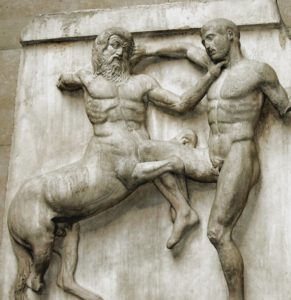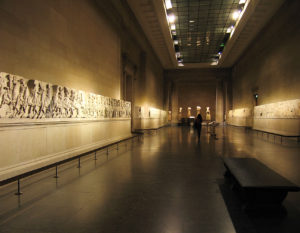 In Bound By A Scandalous Secret, (December, 2016), my hero, Ross, surprises aspiring artist heroine, Genna, with a special visit to view the Elgin Marbles, which (to the best of my research abilities) were housed in a shed behind Burlington House in 1816, when my story takes place.
In Bound By A Scandalous Secret, (December, 2016), my hero, Ross, surprises aspiring artist heroine, Genna, with a special visit to view the Elgin Marbles, which (to the best of my research abilities) were housed in a shed behind Burlington House in 1816, when my story takes place.
The Elgin Marbles are Classical Greek marble sculptures that once decorated the Parthenon and other buildings on the Acropolis of Athens. Originally the Earl of Elgin had obtained a permit from the sultan of the Ottoman Empire who then ruled Greece to make casts of the sculptures, but he noticed that the marbles were being burned for lime to use in other buildings. He decided to rescue them and send them to England. At the time, his acquisition of the marbles was met with mixed support. Some, like Lord Byron, were appalled at their removal. He wrote about it in Childe Harold’s Pilgrimage:
Dull is the eye that will not weep to see
Thy walls defaced, thy mouldering shrines removed
By British hands, which it had best behoved
To guard those relics ne’er to be restored.
Curst be the hour when from their isle they roved,
And once again thy hapless bosom gored,
And snatch’d thy shrinking gods to northern climes abhorred!
Elgin suffered financial reversals and hoped to sell the marbles to the British Government, who eventually exonerated him from acquiring the sculptures illegally. Parliament purchased the marbles in 1816 but at a much lower cost than Elgin had desired. After the purchase, the marbles were housed in the shed behind Burlington House, which held the collections of the British Museum.
Because my hero Ross is the heir to a dukedom, he was able to arrange a private viewing for Genna. Here’s a snippet of that scene:
Huge slabs of marble lined the sides of the shed. Scattered around were ghostly figures. Headless. Armless. Standing. Reclining.
Genna stepped inside reverently. “Oh, Ross!”
She walked along the perimeter where the long slabs of marble that used to decorate the frieze of the Parthenon. The sculpted figures depicted all sorts of figures, men on horseback, on foot or racing chariots, women carrying items, for sacrifice to the gods, perhaps? Everything seemed in motion. Rearing horses, figures interacting, no two the same.
“It must tell a story,” Genna said. “I wish I knew what it was.” She dared to touch the sculpture, almost surprised the figures were not as warm as flesh they were so realistic.
“Here is a Centaur fighting a Lapith,” he said.
It was one segment, not a part of the long procession of figures that had been part of the frieze. Had there been more Centaurs? Did they tell a different story?
The marbles are now in a special room in the British Museum where I’ve been lucky enough to view them three times. They are massive and impressive!
The debate continues as to whether the UK should return the marbles to Greece. All I know is that the British Museum has taken excellent care of them and that there is no guarantee that they would even exist if Elgin had not seen to their preservation.
What do you think? Should the marbles go back to Greece or stay in the British Museum?
 By the way, the last book in my Scandalous Summerfields series, Bound By Their Secret Passion, now has a cover and is available for preorder. It will be released in paperback March 21, in ebook, April 1.
By the way, the last book in my Scandalous Summerfields series, Bound By Their Secret Passion, now has a cover and is available for preorder. It will be released in paperback March 21, in ebook, April 1.





Interesting post, Diane, and thanks for the scene snippet!
As for your question, for me it’s a big “depends”. I think that art and artifacts should generally stay in the region and culture of origin (except maybe for the occasional tour so people who can’t afford the travel can enjoy them). On the other hand, if moving them helps to preserve them, that makes sense, too.
A bit of serendipity–a friend recently told me that there’s a movement now to return items to their origins. Her daughter is studying archaeology and is interested in getting involved in that.
I saw the Elgin Marbles when I was about then years old and even then I was impressed. And grateful, frankly. Had Lord Elgin not saved them and brought them to England I doubt they would have survived the wars, poverty, and ravages of time as well as they have. I realize there is a big movement to return things to their homelands, but until we as a world community stamp out the rampant destruction of our ancient heritage by religious fanatics the Elgin Marbles are probably safer where they are.